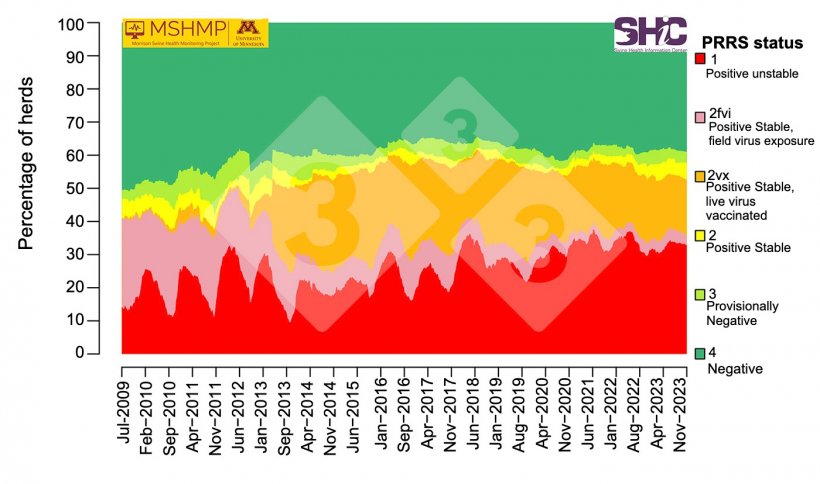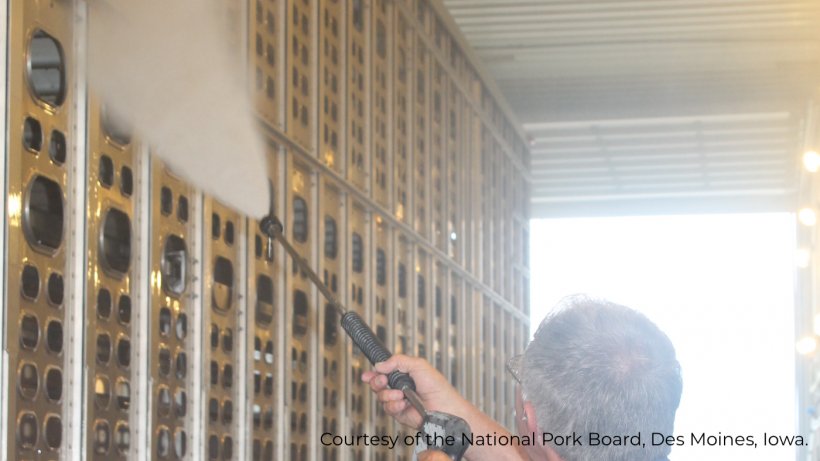On the occasion of Pig333's 25th anniversary, I was asked to review and reflect on the article I wrote in 2005 titled "PRRS virus elimination: Where did we come from and where are we going?" (available in the Spanish edition only). Reading the article again brought back fond memories and nostalgia from an optimistic time when advances in understanding PRRS were significant and hopeful, especially the advances that allowed us to better understand how the virus was transmitted, how we could eliminate it, and how we could prevent new strains from entering farms.
Reflecting almost 20 years later, I am still impressed by what is known about the virus and especially what the swine industry has done to control it, at least in the United States. I don't know of any swine disease that has more radically changed the day-to-day life of farms in the U.S. As they say where I come from... PRRS can move mountains! Although not all changes in biosecurity protocols, replacement animal management, employee policies, or company structural changes were due to PRRS, PRRS was the catalyst for many of them. Likewise, these changes have also affected the control and understanding of other diseases such as mycoplasma, porcine epidemic diarrhea, and most importantly have instigated an attitude of continuous improvement and change that allows the American swine industry to continue to be one of the most efficient in the world. In other words... PRRS has forced us to be better!

However, these advances have not always materialized into ideal and sustainable disease control. The virus continues to change and the challenges are really frustrating as it seems that we have to keep learning the same lessons we already know, along with the occasional new chapter. The challenge is complex and even more so considering that the factors that hinder PRRS control are structural, costly, and changing.
Where are we and where are we going?
Looking back over the past 20 years, we should notice incremental changes that will eventually become transformational.
One of the most important changes is the knowledge gained from the ability to create large databases, analyze that data, and measure disease levels in a systematic way. One of the most innovative and simple systems is the project initiated by Dr. Bob Morrison of the University of Minnesota with the support of veterinarians and producers who voluntarily share PRRS data on a weekly basis. The MSHMP (Morrison Swine Health Monitoring Project), shares PRRS incidence data from sow farms representing more than 50% of the U.S. sow herd. Other databases have followed this initiative, especially those that allow aggregation of diagnostic data.

Figure 1. PRRS prevalence of sow herd status beginning July 01, 2009. Source: Morrison Swine Health Monitoring Project (November 27, 2023). PRRS aggregate prevalence of sow herd status (Last updated November 2023). Morrison Swine Health Monitoring Project. https://mshmp.umn.edu/reports#Charts
The important thing about these initiatives is that nowadays there are collaborations between companies and universities that allow the analysis of PRRS patterns and changes through the use of "Big data". These databases make it possible to include information on virus sequences, animal movements, health status, and more... and are the basis for applying artificial intelligence to determine patterns that we would not be able to see if we were to analyze these same parameters on only an individual level.
Access to and implementation of big data and statistical algorithms such as machine learning will continue to revolutionize how we understand and manage PRRS.
Another point to highlight in the area of diagnostics is the PRRS whole gene sequencing. Nowadays there are cheaper methods to partially or totally sequence the virus, which allows us to better understand the genetic keys of the virus. There are thousands of sequences being analyzed on a continuous basis that allow us to determine trends and predictions. One point to emphasize is that the PRRS virus does what it does best... change... and new strains keep appearing. The virus not only mutates rapidly but also recombines resulting in new, structurally different strains that can result in an even more devastating PRRS.
New strains of PRRS appear in the United States every 3-7 years, displacing other strains and causing earthquakes in terms of economic losses.
In the U.S. we recently saw the emergence of the 144 L1C strain and in Spain the emergence of the famous Rosalia which reminds us that we cannot settle for thinking that we already know how to control PRRS; we must continue to fight to keep it out of farms.
It's frustrating to see the emergence of these new strains when we thought we knew how to control the virus! The emergence of these strains serves as a reminder to me that PRRS control must include nursery and finishing pigs. We know how to eliminate the virus on the sow farm, and we can do it relatively quickly and easily, but what we don't know is how to consistently control PRRS in the postweaning period. There are three necessary points:
- Wean negative piglets
- Prevent the entry of new strains (biosecurity)
- Decrease/prevent viral replication in these animals
We need pharmaceutical solutions whether that means antiviral products or protective vaccines that can significantly lower the viral load, protect against multiple strains, and stop transmission of the virus.
The frustration of biosecurity: The challenge of implementing it systematically, simply, consistently, and inexpensively
My favorite but most frustrating topic is to talk about "biosecurity". Although we have come a long way in understanding how the virus moves and in many cases production companies have implemented effective biosecurity protocols, we must recognize that production systems are complex and that the production chain contains many critical points that are fragile and must be systematically reinforced. Biosecurity measures such as air filtration, segregation, truck washing, and disinfection are essential, but the challenge remains to implement them in a systematic, simple, consistent, and inexpensive manner. Going forward, we will continue to see companies implement biosecurity programs efficiently, as long as the return on investment of biosecurity measures can be justified. What we have learned is that before initiating virus elimination programs, we must first have preventive biosecurity measures in place on the farms. In other words, we must not put the cart before the horse!

Figure 2. Power washing transport truck. Photo courtesy of the National Pork Board.
Finally, I cannot fail to mention the importance that could represent having animals that are resistant to the PRRS virus. What seemed like science fiction is now a reality thanks to the use of technologies that make it possible to edit the pig genome. It has been demonstrated that if the receptor that allows PRRS infection (CD 163 receptor) is modified, pigs do not become infected. This scientific achievement should be celebrated and may represent a transformational change in how PRRS control is addressed. However, science and the consumption of technologically altered products do not always go hand in hand and it is unclear how consumers will react to the knowledge that pork may have been gene-edited. In other words, there is a lot of uncertainty as to whether PRRS-resistant pigs will actually occupy an important place in the U.S. market.
What else should we consider?
The cost of PRRS is too significant to be ignored. We must continue to look at how to implement better control measures and focus on preventing infections not only on the sow farm but also in the post-weaning phases so that we can then consider elimination programs at the system, regional, or national level. Regional elimination programs will only be possible if we first strengthen biosecurity and collaboration. Finally, we should expect a better understanding of the genetic and antigenic aspects of viruses thanks to databases and analyses made possible by artificial intelligence. These analyses may be key to developing new vaccines, new antiviral products, or new knowledge that will allow us to more effectively prevent the virus from moving between farms.

I would like to conclude this article with the prediction that in another 20 years, the PRRS virus will no longer represent a challenge to the swine industry, however, I am convinced that it will continue to be present and cause problems. Producers and veterinarians will continue to gather key information to advance in the control of PRRS and this knowledge will allow progress in other diseases that also impact the swine industry. Let's hope that advances are significant so producers can improve their competitiveness and the health status of their farms!





